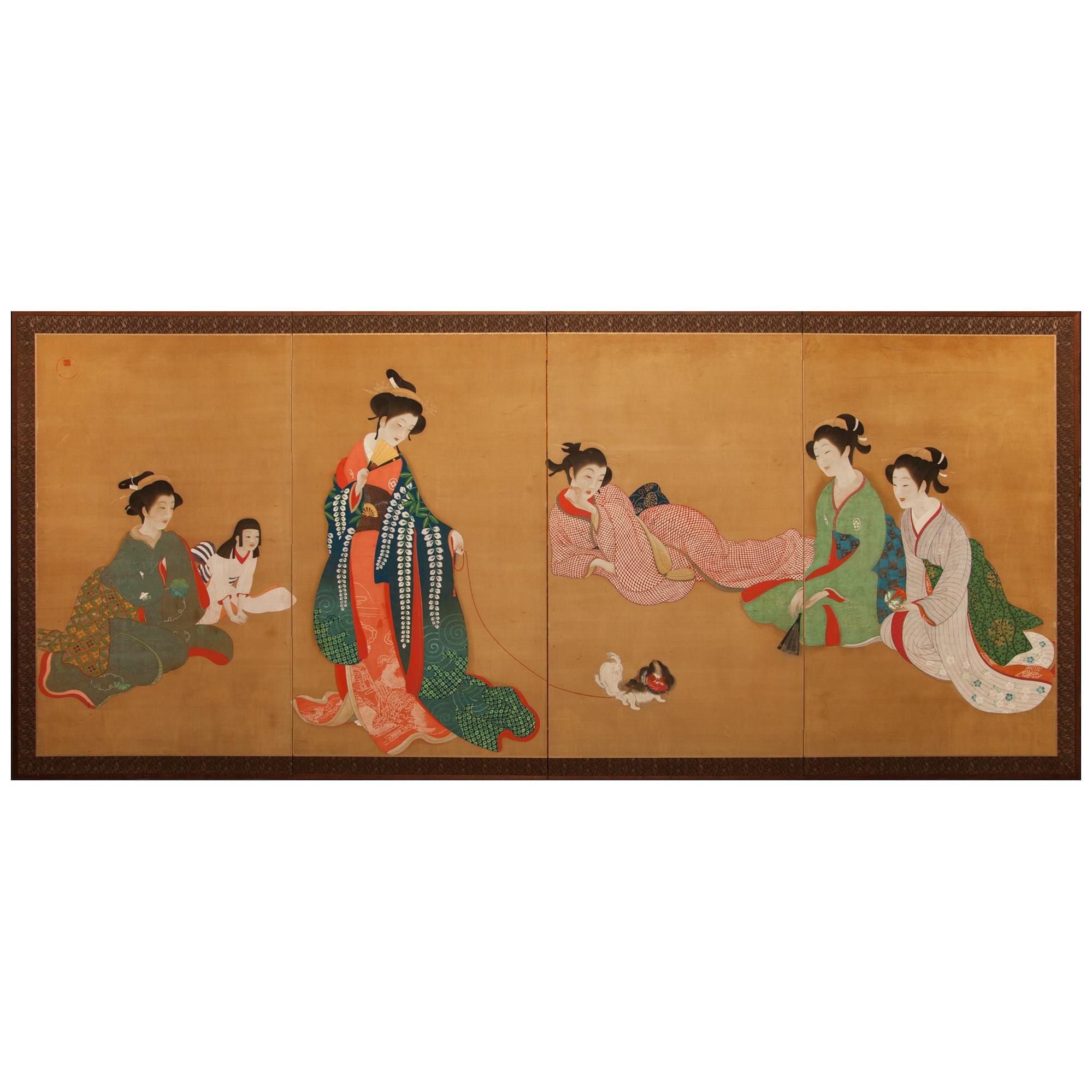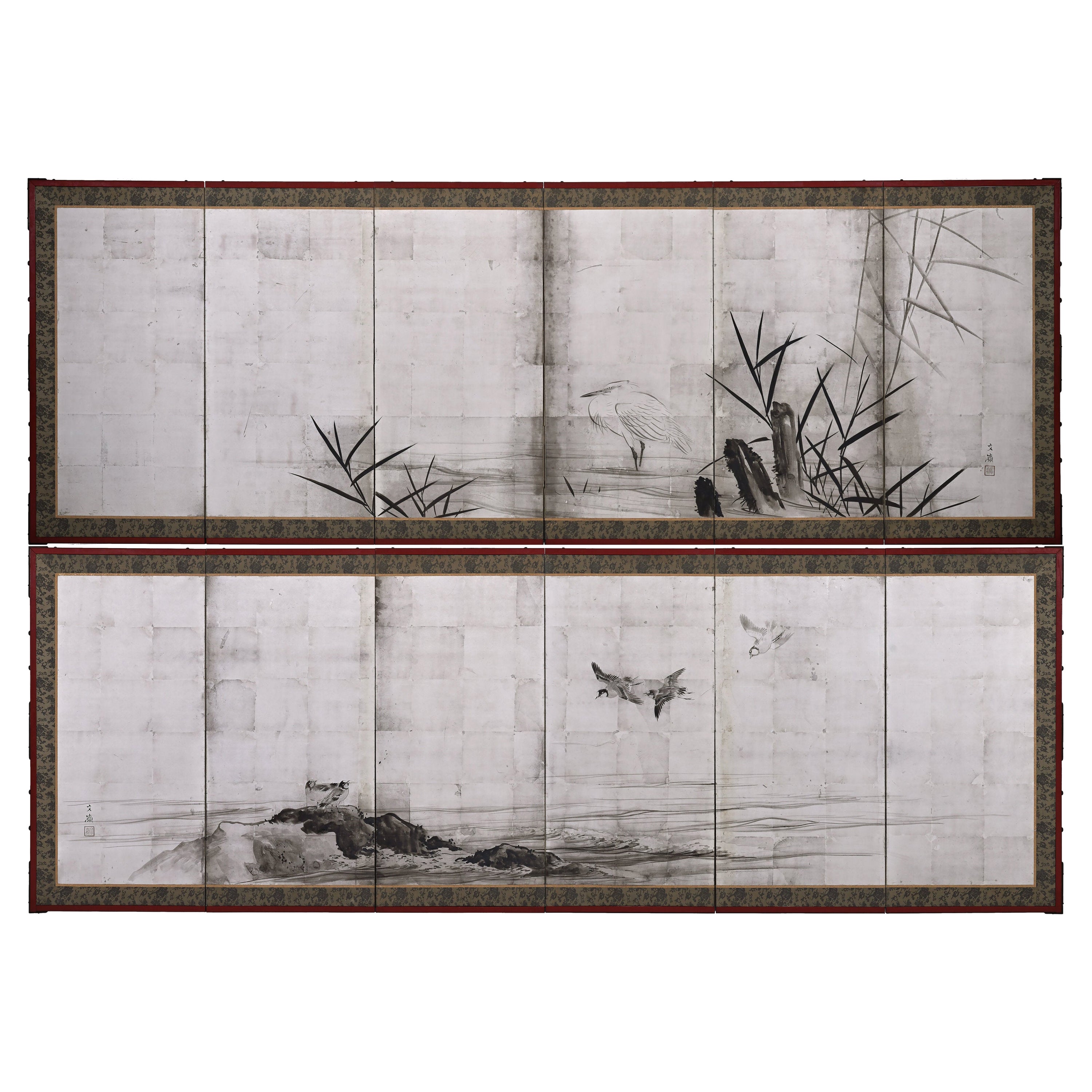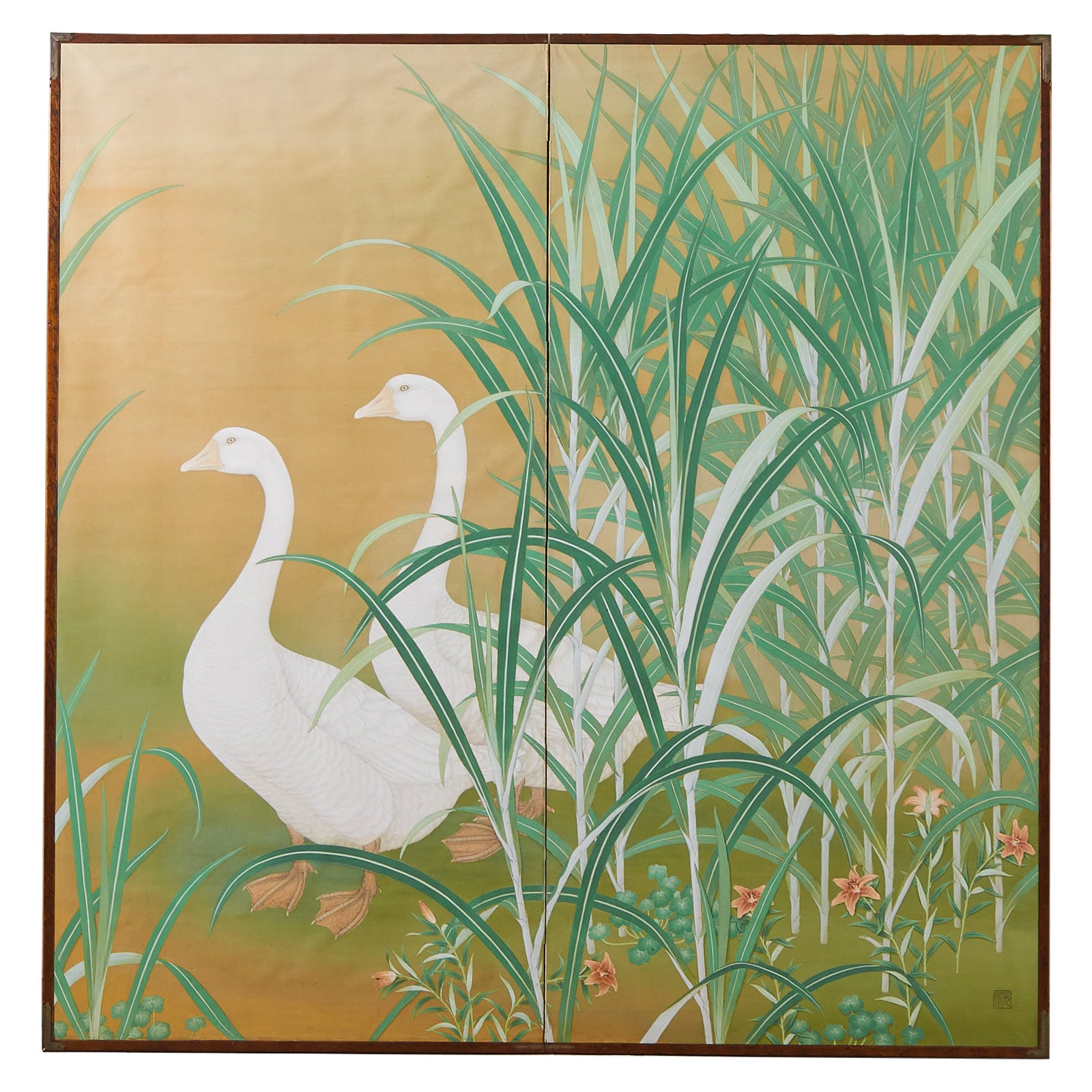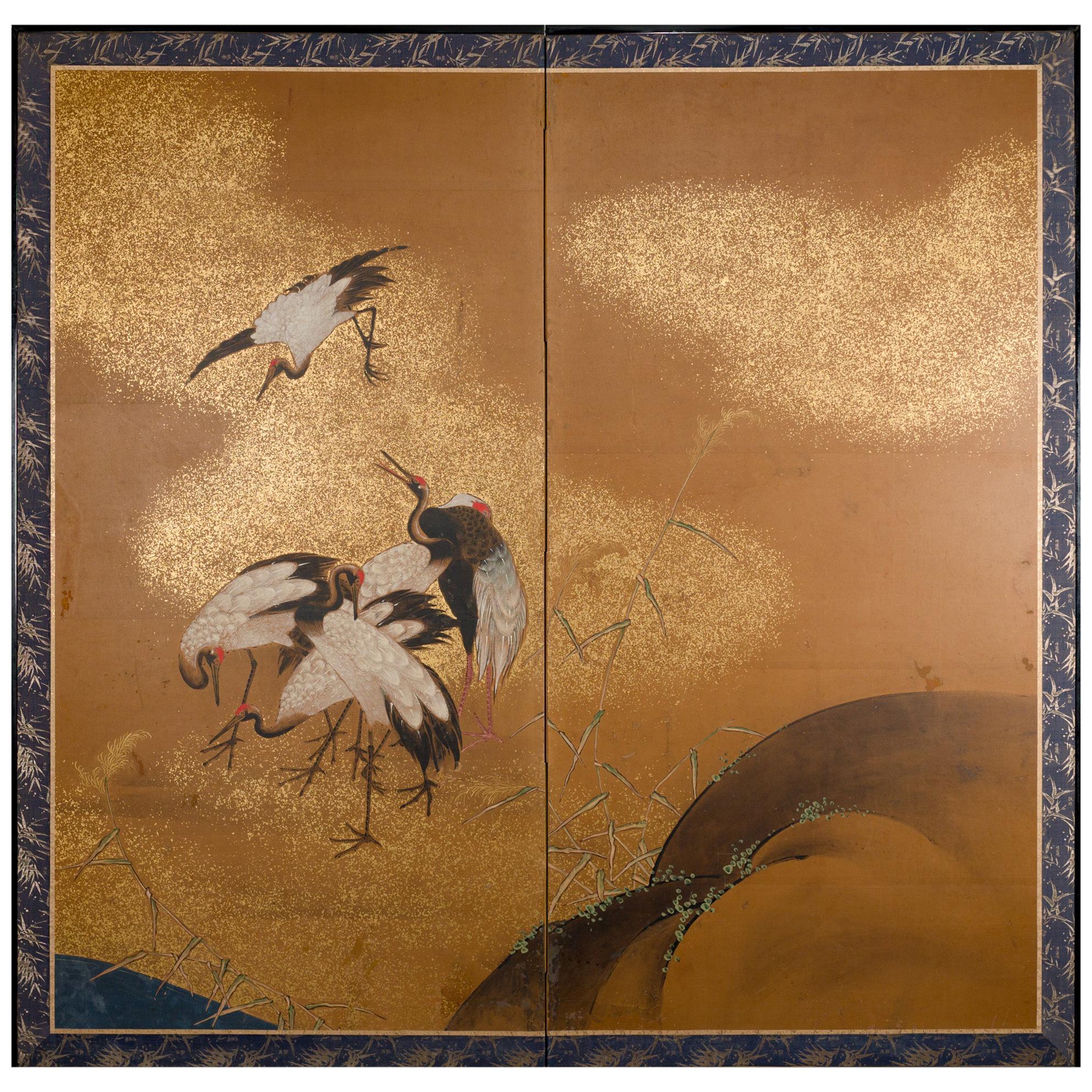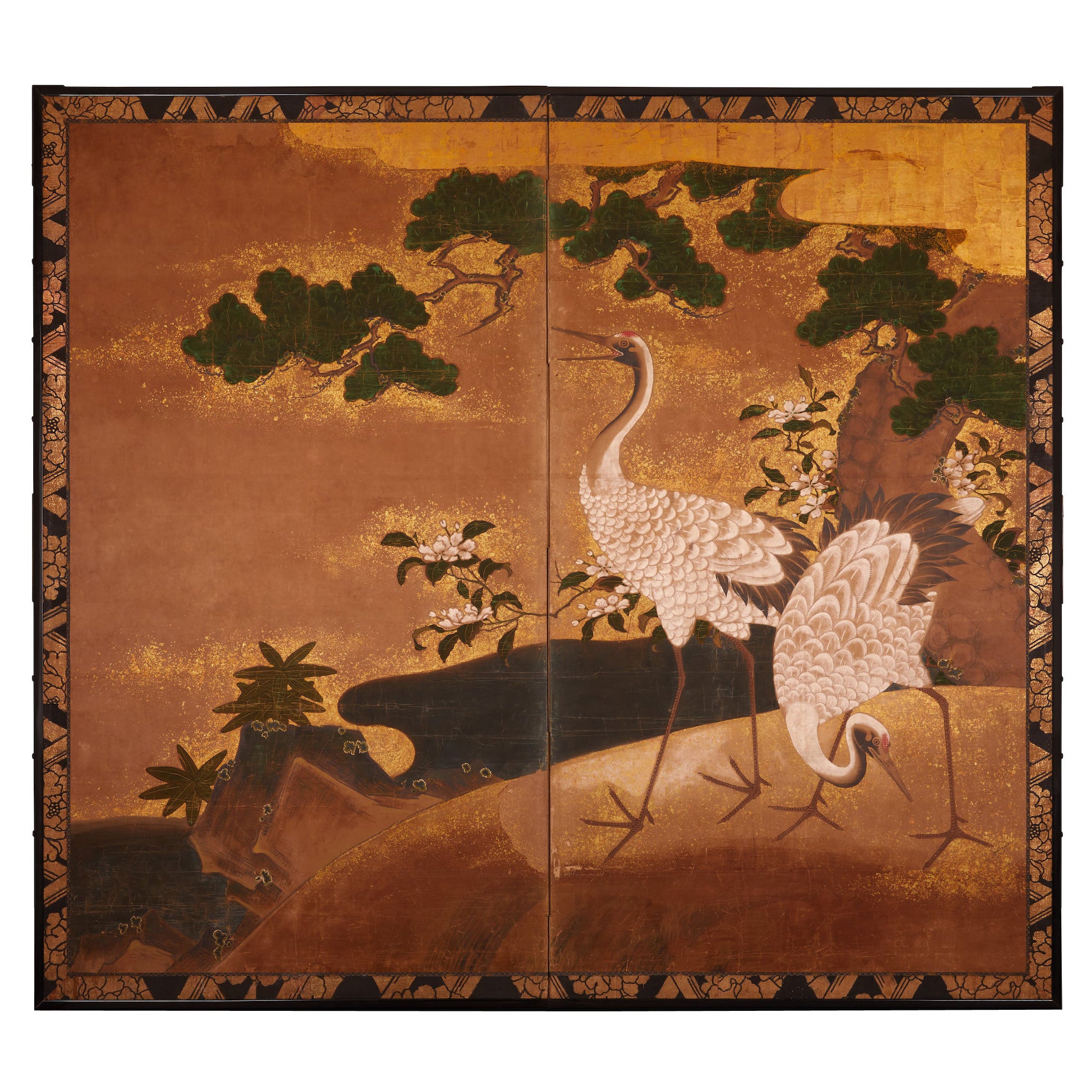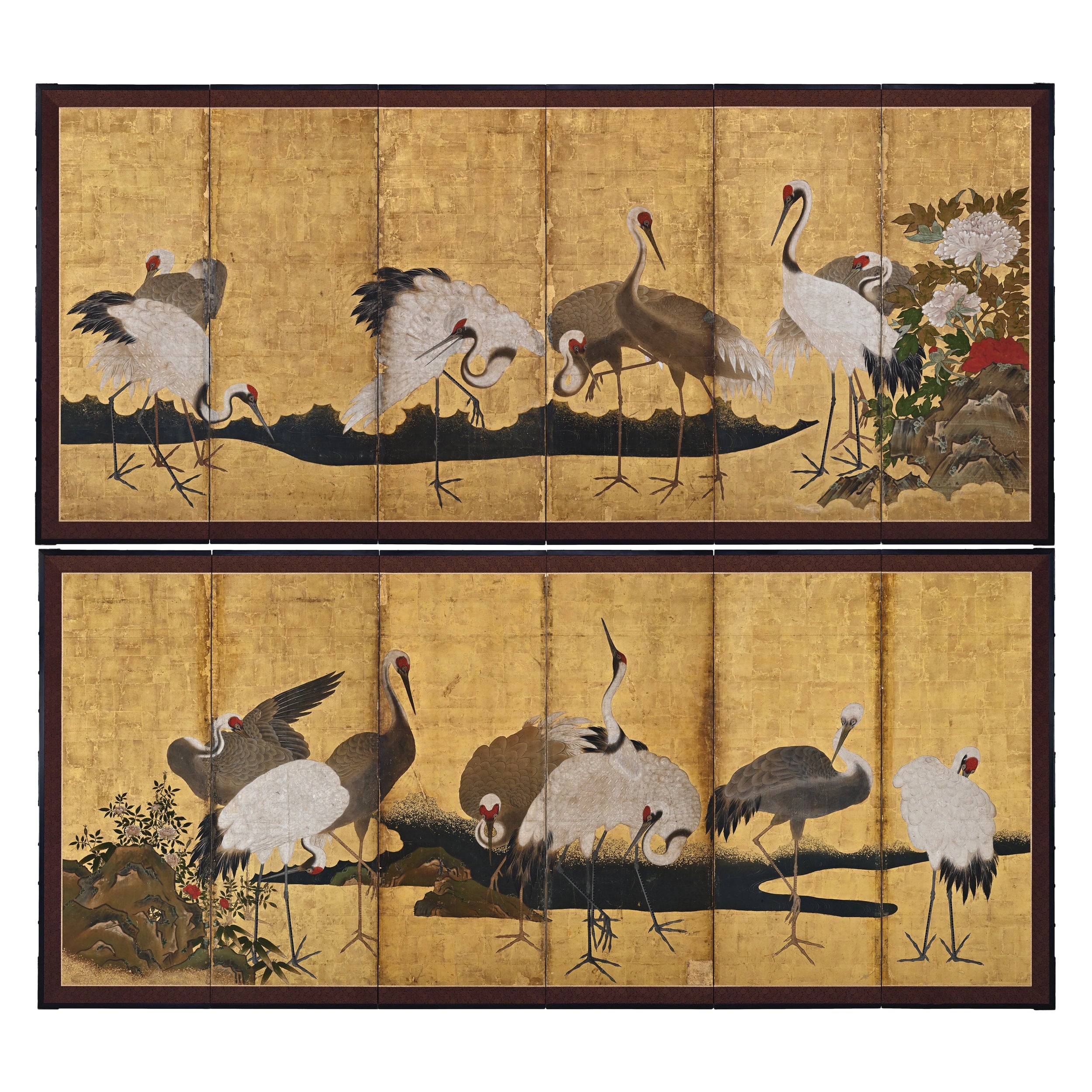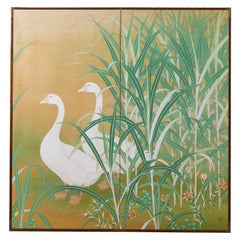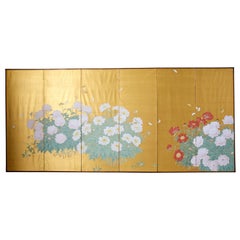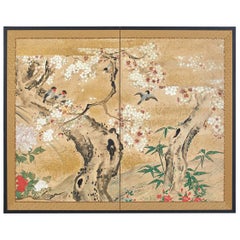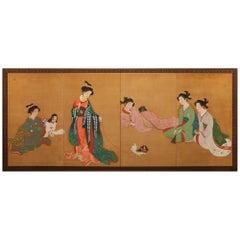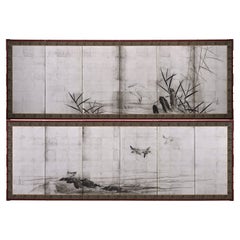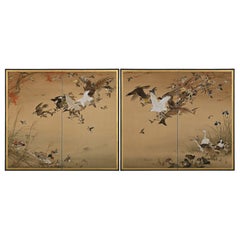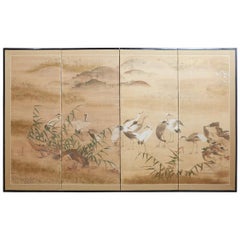
Japanese Meiji Period Screen of Red-Crowned Cranes
View Similar Items
Want more images or videos?
Request additional images or videos from the seller
1 of 17
Japanese Meiji Period Screen of Red-Crowned Cranes
About the Item
- Dimensions:Height: 60 in (152.4 cm)Width: 98 in (248.92 cm)Length: 60 in (152.4 cm)
- Style:Meiji (Of the Period)
- Materials and Techniques:
- Place of Origin:
- Period:
- Date of Manufacture:Early 20th Century
- Condition:Minor stains, foxing, and older repairs, but shows beautifully with no major losses on front.
- Seller Location:Rio Vista, CA
- Reference Number:1stDibs: LU1555212038993

About the Seller
5.0
Erin Lane Estate is based in the San Francisco Bay Area, and its team of furniture restorers, art curators, professional appraisers and Asia specialists sources prime vintage and antique furniture from the finest estates in Northern and Southern California. Erin Lane Estate specializes in Hollywood Regency, McGuire, Chinese and Japanese pieces.
Diamond Seller
These expertly vetted sellers are 1stDibs' most experienced sellers and are rated highest by our customers.
Established in 2000
1stDibs seller since 2015
2,660 sales on 1stDibs
Typical response time: 1 hour
More From This SellerView All
- Japanese Meiji Two Panel Screen Geese and ReedsLocated in Rio Vista, CAFantastic Japanese late Meiji period two-panel byobu screen by Hashimoto Koshu. The large screen features two white geese amid brightly colored reeds. The symbolism of geese and reeds was introduced to Japan from China in the 13th century. This was a popular subject for Japanese zen artists of the period. Beautifully crafted with exceptional brush strokes and details. Made with natural pigments in dramatic vivid colors of white, pink, and mint green on a silk background of gilt. Circa 1900 with artist seal on bottom right corner. Koshu studied Western art under...Category
20th Century Japanese Meiji Paintings and Screens
MaterialsSilk, Wood, Paper
- Japanese Six-Panel Meiji Screen Flowering Peonies and ButterfliesLocated in Rio Vista, CAStunning Japanese Meiji period six-panel large screen. Featuring blooms of spring flowering white, pink, and red peonies with butterflies over a gilt background. Made in the Nihonga ...Category
20th Century Japanese Meiji Paintings and Screens
MaterialsBrass
$7,200 Sale Price20% Off - Japanese Meiji Two Panel Screen Song Birds in SakuraLocated in Rio Vista, CAExceptional Japanese Meiji period two-panel screen, circa 1900. Featuring songbirds amid sakura cherry trees and flowering peony. Made in the Nihonga School style on handcrafted mulb...Category
20th Century Japanese Meiji Paintings and Screens
MaterialsBrass
- Pair of Japanese Meiji Six Panel Screen Cranes Above Cresting WavesLocated in Rio Vista, CAAmazing 19th century pair of large Japanese Meiji period six panel screens each depicting a sedge of Manchurian red-crowned cranes along the shore. The screens are crafted in the Nih...Category
Antique 19th Century Japanese Meiji Paintings and Screens
MaterialsBrass
- Japanese Showa Six Panel Screen Manchurian Crane Bamboo GroveLocated in Rio Vista, CAEnchanting Japanese Showa period six-panel byobu screen titled "Bamboo Forest-Immortal Together". The large screen depicts six manchurian cranes in a ...Category
20th Century Japanese Showa Paintings and Screens
MaterialsBrass
$3,600 Sale Price20% Off - Japanese Edo Period Six Panel Screen of Chinese ScholarsLocated in Rio Vista, CAFascinating 19th century Japanese late Edo period six pane funpon screen. Large scale depicting Chinese scholars and officials engaged in leis...Category
Antique 19th Century Japanese Edo Paintings and Screens
MaterialsWood, Paper, Silk
You May Also Like
- Meiji Period Japanese Four Panel Screen Bijin At LeisureLocated in Hudson, NYJapanese four panel screen: Bijin At Leisure. Ladies in a tea house with a small dog. Seal reads "Ensan dai" (drawn by Ensan). Meiji Period (1868 - 1912) pa...Category
Antique Late 19th Century Japanese Meiji Paintings and Screens
MaterialsSilk, Wood
- Japanese Silver Screen Pair, Meiji Period, Herons & Plovers, Shijo SchoolLocated in Kyoto, JPHeron & Plovers Ink and silver leaf on paper Maekawa Bunrei (1837-1917) A pair of low six-panel Japanese screens by Maekawa Bunrei, a later master of the Kyoto based Shijo school of painting. On the right screen a solitary white heron stands motionless in a stream. On the left screen plovers play along a shoreline. The elegant forms are executed employing fluid, minimalistic ink brushstrokes. The soft brushstrokes and the sharp light of the silver leaf lend the scenes a sense of translucence. The sophisticated composition superbly exploits the long, horizontal pictorial surface of the pair of folding screens...Category
Antique Early 1900s Japanese Meiji Paintings and Screens
MaterialsSilver Leaf
- Meiji Period Japanese Screen Pair, One Hundred Birds by Hasegawa GyokujunLocated in Kyoto, JPOne hundred birds Hasegawa Gyokujun (1863-1921) Meiji period, circa 1900. Ink, color and gofun on silk. Dimensions of each screen: H. 170 cm x W. 190 cm (67’’ x 75”) Despite the title, well over 100 birds are represented in this pair of two-fold Japanese screens (the title functions figuratively to convey the idea of a large number). The monumental work is rendered with a comprehensive and highly complex composition which is exquisitely executed and meticulously colored. More a celebration of naturalism than the traditional “One Hundred Birds” paintings which originated in China. This was a subject matter known for its auspicious meaning as much as its actual depiction of nature. These paintings generally had a phoenix (occasionally peacocks) placed in the center, and the other birds paying homage to it. In this quintessentially Japanese scene painted by Gyokujun, a couple of long-tailed birds modeled after paradise flycatchers are included; these are traditional auspicious motifs in Oriental bird and flower painting and denote themes such as celebration and enduring generations. In addition there is the playful inclusion of single exotic parrot. Even so, the vast majority of the birds and flowers are native to Japan. Reading the scene from right to left, from spring through to autumn, the overwhelming sense is one of movement and haste. It is almost as if the birds are in a race, with the fleetest leading the way forward. Although these native birds were commonly drawn amongst artists of the Shijo school, rarely were they painted with such drama and dynamism. It is not strictly a depiction of sketched birds whose manner was faithfully handed down through the traditions of the Shijo school. Rather we see Gyokujun seeking and achieving new expressions in the heart of the turbulent Meiji period. Hasegawa Gyokujun (1863-1921) was born in Kyoto. He was the eldest son of Hasegawa Gyokuho, a Shijo school painter who studied under Matsumura Keibun. Gyokujun studied painting under his father and became a prominent member of the Kyoto painti ng world from a young age. In 1891 he established the ‘Young Painters Social Club’ along with Takeuchi Seiho, Miyake Gogyo and Taniguchi Kokyo. Also in 1891 he was selected as a judge of the Great Private Paintings Exhibition along with Takeuchi Seiho, Yamamoto Shunkyo...Category
Antique Early 1900s Japanese Meiji Paintings and Screens
MaterialsSilk, Wood
- Japanese Two Panel Screen Sedge of Cranes in Rolling Landscape with Gold CloudsLocated in Hudson, NYMeiji period (1868-1912) painting of a group of cranes gathering next to water's edge with gold dust clouds in the background. The scene is accented by wild grasses and lichen on the...Category
Antique Late 19th Century Japanese Meiji Paintings and Screens
MaterialsGold
- Meiji Era, Circa 1900 Japanese Screen Pair, Flowers & Birds of Spring & AutumnLocated in Kyoto, JPFlowers & Birds of Spring and Autumn Unknown artist. Japan. Meiji period, circa 1900. A pair of six-fold screens. Ink, color, gofun and gold leaf on paper. Signed: Gaga S...Category
Antique 1890s Japanese Meiji Paintings and Screens
MaterialsGold Leaf
- Japanese Two-Panel Screen: Cranes on GoldLocated in Hudson, NYEarly Kano School painting of pine trees overlooking two beautifully painted cranes and floral design in a natural setting by water’s edge. Mineral pig...Category
Antique Late 18th Century Japanese Paintings and Screens
MaterialsGold, Gold Leaf
Recently Viewed
View AllMore Ways To Browse
Crane Screen
Meiji Cranes
Asian Crane Panel Art
Japanese Screens And Cranes
Japanese Crane Screen
Japanese Screen Cranes
Japanese Crane Panel
Japanese Screens With Cranes
Crown Crane
Crowned Crane
Gold Leaf Cranes
Gold Screen Crane
Crane Paintings Gold Leaf
Red Crown Cranes
Red Crowned Crane
Asian Gold Leaf Panels With Cranes
Antique Asian Paintings
Antique Asian Painting
